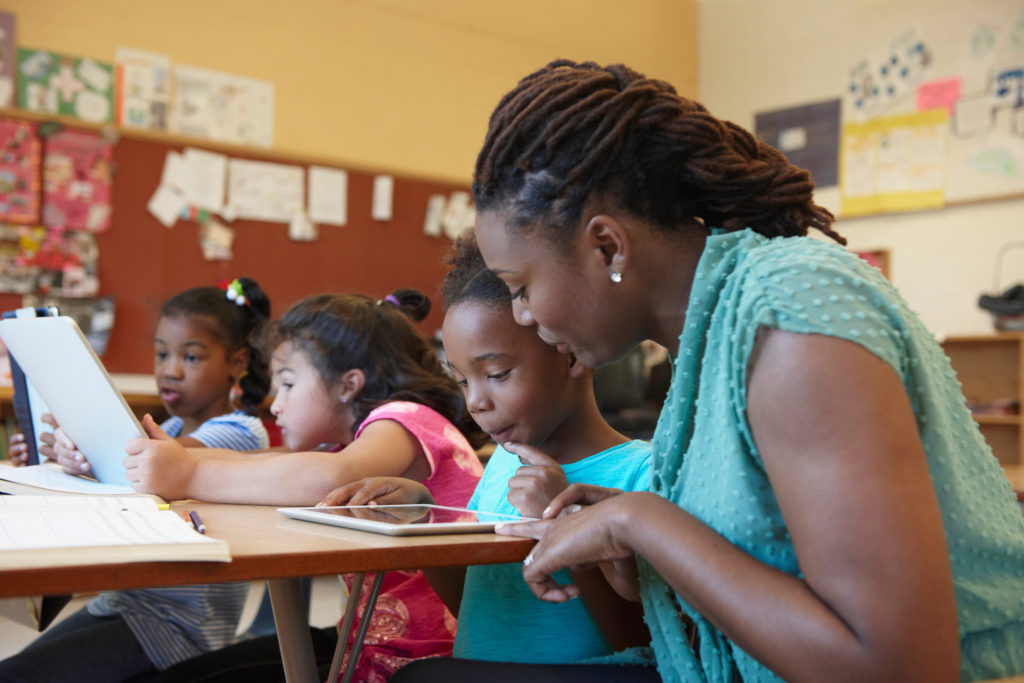April 15, 2024
Every educator has heard the phrase “Practice makes perfect.” But as Vince Lombardi famously said, “Practice does not make perfect. Only perfect practice makes perfect.”
So, what is “perfect” practice?
As two of my colleagues recently explained, reading practice is perfect when it includes two essential components to support each student’s journey from learning to read to reading to learn:
- Individualized skills practice.
- Dynamic reading practice.
What does this journey involve? Students who have “cracked the code” and can pair letters with their sounds require lots of reading practice so they can fluently decode words in text. We call this “dynamic” practice because students need opportunities to read a variety of grade-level texts—beginning with decodables and advancing to poems, plays, articles, and more—to encourage stamina, speed, and joy.
For this reason, dynamic reading practice also calls for fluency instruction.
Fluency is the ability to read with automaticity, accuracy, and prosody to derive and communicate meaning. Think of fluency as a “bridge” connecting word recognition and language comprehension skills with reading comprehension. Without instruction, students are often challenged to build this bridge.
As a former classroom teacher and literacy professor, I have years of experience teaching reading and helping educators to understand evidence-based instructional strategies. I’m also co-author of a new book on fluency instruction, and I’m happy to share some key insights in this blog.

Sight words, phonics skills, and reading fluency
If you’ve taught reading, you’ve likely heard the mantra, “Every word wants to be a sight word.” When students learn to decode words—regardless of their orthographic patterns—and convert them to memory, these words become sight words. Why do students need to have a growing bank of sight words?
When we recognize words instantly without sounding them out, we’re more likely to read fluently and to comprehend.
Students who learn to “glue” letters to their sounds can decode without realizing they’re doing so. When they encounter an unfamiliar word, however, they can flex their word decoding muscles to decipher it, thanks to explicit phonics instruction. Glueing letters to sounds is step one.
But reading fluently requires more than phonics. As my colleague Tim Rasinski says, “The goal of phonics instruction is to get students not to use phonics.” So, how do we ensure students learn to decode effortlessly and read fluently, without having to sound out every word they encounter? We explicitly teach fluency.
Reading fluency instruction: An essential first step
Assessments don’t close reading gaps, but they shed light on how students are performing and which gaps need to be closed. If you’re reading this blog, you’re likely familiar with the recent National Assessment of Educational Progress (NAEP) data.
We know that we have a literacy crisis exacerbated by the COVID-19 pandemic. To address this, teachers need to provide explicit, systematic, and evidence-based instruction focused on developing all foundational reading skills: phonological awareness, phonics, fluency, vocabulary, and comprehension (Shanahan, 2022).
Unfortunately, fluency is often misunderstood and is the neglected goal of reading instruction (Allington, 1983; Drake & Walsh, 2020). In fact, teachers often spend a significant amount of time assessing oral reading fluency but very little time teaching it. Fluency doesn’t happen naturally; instead, it’s the result of explicit instruction and purposeful practice.
Ironically, most teacher prep courses devote very little time to training teachers how to teach fluency (Drake & Walsh, 2020), and scaffolded reading practices aren’t always baked into lesson plans. How can we move forward?
Building confident readers
Discover Renaissance solutions that promote more purposeful reading practice.
Evidence-based strategies for reading fluency instruction
We’ve likely all heard a fluent reader whose rate, accuracy, and prosody awaken a snoozing audience, champion change, or promote peace. Fluent reading is an essential skill, and, at Renaissance, we understand students need fluency instruction and large amounts of practice to become successful readers.
We also know that instructional time and students’ attention spans are limited. How can teachers maximize instructional time, engage students, and help them to become fluent readers? A common first step is assisted reading.
Assisted reading includes a variety of collaborative practices in which students read a text while listening to a fluent rendering of that text. There are three types of assisted reading that are designed to build fluency and scaffold all readers, including multilingual learners:
- Choral reading: A whole class, small groups, or pairs of students read aloud simultaneously.
- Echo reading: An “I Do–You Do” technique, where students listen to a reader and follow along in a text before they echo what they’ve heard.
- Audio assisted reading: Students read along and track the text while listening to an audio version.
In addition to these evidence-based practices, the following strategies are also effective in promoting fluency.
Fluency strategy #1: Repeated reading
Students who are challenged to fluently read texts at grade level benefit from multiple opportunities to independently reread those texts. Here, practice does make perfect! In fact, studies suggest that repeated reading not only improves fluency with the original text but on subsequent texts as well (Kuhn et al., 2006).
Fluency strategy #2: Phrased reading
Fluent readers read in phrases, whereas less fluent readers are inclined to read word-by-word and are less likely to make meaning. Clearly, the goal of reading is comprehension, and the meaning of a sentence is carried by phrases, so chunking words together in phrases is beneficial (Rasinski & Padak, 2001).
How are your students practicing the sight words they need to convert to memory? Consider taking the list of sight words and embedding them into phrases or short sentences for students to practice reading. Ideally, create phrases that reflect students’ experiences and include punctuation.
When I taught grade 1, I wrote and displayed 27 short sentences about each of my students. They then practiced reading these aloud, rather than reading sight words in isolation. If every word wants to be a sight word, then every sight word wants to be meaningful, and phrased reading provides meaningful context.
Fluency strategy #3: Readers’ theater
Readers’ theater helps students to develop both fluency competencies and performance skills. Helpful for motivating even the most reluctant readers, this strategy relies on “practice makes perfect” as students reread lines in a script while preparing to perform it for an authentic purpose.
The beauty of this practice is that the focus is entirely on reading performance without concerns for costumes, scenery, or props.
While ready-to-use scripts are available from curriculum publishers, scripts can also be developed from model texts. For example, culturally diverse fairytales and folklore are often script-friendly and enhanced with “mirrors, windows, and sliding glass doors” for all students (Bishop, 1990). Your multilingual learners will appreciate any text that celebrates their culture and provides the chance to practice and collaborate authentically with peers.

The Fluency Development Lesson: A proven approach to teaching fluency
All of the practices I’ve discussed so far help students to become fluent readers. However, when each of these practices is combined into an integrated fluency lesson, we get an outcome greater than its individual components. This synergy is the Fluency Development Lesson.
The Fluency Development Lesson is a systematic, explicit, and science-backed instructional practice that—when implemented regularly—engages students and closes reading gaps. It improves foundational reading skills and comprehension for all students, including multilingual learners (National Reading Panel, 2000; Kulich, 2009; Zimmerman et al., 2019). While the Fluency Development Lesson supports all foundational reading skills, it targets fluency because difficulties for striving readers often manifest in this area (White et al., 2021). It can also be adapted to support readers of all ages.
The Fluency Development Lesson can be implemented in 15–20 minutes, and it’s comprised of effective reading practices like echo, choral, and repeated reading. The original Fluency Development Lesson was designed to be delivered in a single day using short, grade-level passages (Rasinski, 2010; Rasinski et al., 1994). Research suggests that scaffolded, repeated reading of a single text over the course of a week leads to gains in fluency and comprehension skills for elementary readers (Stahl & Heubach, 2005).
I adapted the original Fluency Development Lesson format to allow students to read the same text throughout the week, with varying degrees of support. In addition, I embedded a variety of activities to target all literacy skills: listening, speaking, reading, and writing. You’ll also find that my week-long lessons include opportunities for students to continue developing all foundational reading skills, not just fluency.
Planning the Fluency Development Lesson: 4 steps for success
I followed a four-step process to create the lessons shared in my new book. I’d suggest following a similar process if you’d like to create your own lessons.
#1: Choose a grade-level text
Select a grade-level text that aligns with a unit of study, theme, or phonics skill. You can select any genre, but my favorite is poetry. Given its rich, rhythmic language, poetry is a natural choice. This is especially true when supporting multilingual learners, who benefit greatly from the rhythm, rhyme, and repetition that poetry offers (Vardell, Hadaway, & Young, 2006).
#2: Identify assisted reading practices
Next, determine the assisted reading practices needed to support your students, and plan to explicitly teach new vocabulary. Remember students will initially need more scaffolding earlier in the week. Prepare to discuss the poet’s purpose, choice of words, and theme—comprehension is the goal here.
#3: Connect reading and writing
Embed opportunities for students to perform for different audiences, and also include a written response activity. Reading and writing are synergistic, so be sure students write about the poem and have opportunities to share their responses. This experience helps develop the necessary dialogic communication skills students will use outside of the classroom.
#4: Prioritize family engagement
To support home-school partnerships, have students read the poem to someone at home. In the spring of each school year, I honored my readers with a poetry party and invited family members and school and community leaders to listen to the students read their favorite poems.
The Fluency Development Lesson: A day-by-day guide
The following breakdown shows you how the Fluency Development Lesson translates to daily lesson planning.
| Monday: • Introduce the poem. • Model fluent reading. • Discuss the poet’s purpose and style. • Identify rhymes, onomatopoeias, alliteration, etc. • Have students chorally echo read. |
| Tuesday: • Reread the poem. • Review the components of fluency (rate, accuracy, and prosody). • Have students chorally read the poem. • Have small groups read different stanzas. • Have students locate words with long/short vowel sounds, digraphs, synonyms, and antonyms. |
| Wednesday: • Read the poem chorally with your students. • Have students partner-read. • Ask partners to provide feedback. • Have students volunteer to read the poem for the class. |
| Thursday: • Have students chorally read and self-evaluate. • Ask volunteers to read for the class. • Have students read the poem to their families. • Have students complete a writing activity. |
| Friday: • Have students read the poem with different emotions. • Have students perform for different school audiences. • Record “mystery readers” and ask students to guess their identities. |
The Fluency Development Lesson: Closing the Reading Gap
In my travels, I’ve met with educators who are eager to implement the Fluency Development Lesson with their students. To be clear, the Fluency Development Lesson is not a core curriculum but rather an instructional practice for using grade-level texts aligned to both your curriculum and scope and sequence.
I’m often asked if I have texts with ready-made lessons that teachers can use. I get it—time spent searching for that just-right text and reading activity could instead be spent delivering instruction.
So, I’m thrilled to announce the release of my book, The Fluency Development Lesson: Closing the Reading Gap. I collaborated with Tim Rasinski and David Harrison to create 28 poems and 140 lessons with Word Ladders for grades 1‒5. The poems are aligned to multiple science and social studies strands, and the corresponding lessons—which are packed with rigorous, collaborative activities—will:
- Save you time.
- Engage all students.
- Help to create fluent readers.
You can order the book directly from the publisher. It is also available from Amazon and other online retailers.
I look forward to hearing feedback as educators implement the Fluency Development Lesson in their classrooms and across their schools and districts!
References
Allington, R.L. (1983). Fluency: The neglected reading goal. The Reading Teacher, 36(6), 556‒561.
Bishop, R. S. (1990). Mirrors, windows, and sliding glass doors. Perspectives: Choosing and Using Books for the Classroom, 6(3), ix‒xi.
Drake, G., & Walsh, K. (2020). 2020 teacher prep review: Program performance in early reading instruction. National Council on Teacher Quality.
Kulich, L. S. (2009). The English reading development of Karen children using the Fluency Development Lesson in an intensive English language program: Three descriptive case studies. Doctoral dissertation, University of Akron.
Kuhn, M. R., Schwanenflugel, P. J., Morris, R. D., Morrow, L. M., Bradley, B. A., Meisinger, E., Woo, D., & Stahl, S. A. (2006). Teaching children to become fluent and automatic readers. Journal of Literacy Research, 38, 357–387.
National Reading Panel. (2000). Teaching children to read. Reports of the subgroups. Washington, DC: US Department of Health and Human Services, National Institutes of Health.
Rasinski, T. V. (2010). The fluent reader: Oral reading strategies for building word recognition, fluency, and comprehension (2nd ed.). New York: Scholastic.
Rasinski, T. V., & Padak, N. D. (2001). From phonics to fluency: Effective teaching of decoding and reading fluency in the elementary school. New York: Pearson.
Rasinski, T. V., Padak, N. D., Linek, W. L., & Sturtevant, E. (1994). Effects of fluency development on urban second-grade readers. Journal of Educational Research, 87, 158–165.
Shanahan, T. (2022, Sept 10). What do you think of “phonics first” or phonics only” in the primary grades? Shanahan on Literacy. Retrieved from: https://www.shanahanonliteracy.com/blog/what-do-you-think-of-phonics-first-or-phonics-only-in-the-primary-grades
Stahl, S., & Heubach, K. (2005). Fluency-oriented reading instruction. Journal of Literacy Research, 37, 25–60.
Vardell, S. M., Hadaway, N. L., & Young, T. A. (2006). Matching books and readers: Selecting literature for English learners. The Reading Teacher, 59(8), 734–741.
White, S., Sabatini, J., Park, B. J., Chen, J., Bernstein, J., and Li, M. (2021). The 2018 NAEP oral reading fluency study. Washington, DC: US Department of Education, Institute of Education Sciences, National Center for Education Statistics.
Zimmerman, B.S., Rasinski, T.V., Kruse, S.D., Was, C.A., Rawson, K.A., Dunlosky, J., & Nikbakht, E. (2019). Enhancing outcomes for struggling readers: Empirical analysis of the fluency development lesson. Reading Psychology, 40(1), 70‒94.
Connect with an expert to explore Renaissance solutions for high-impact reading practice across pre-K‒12.

